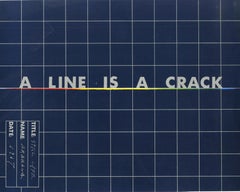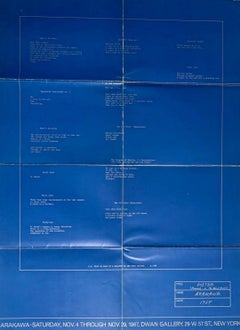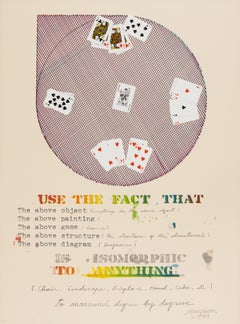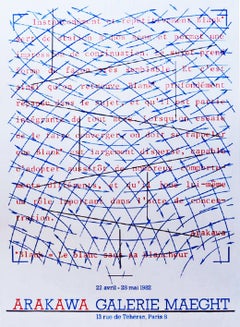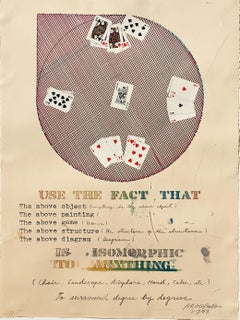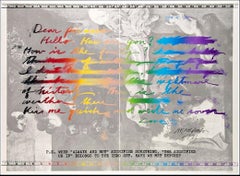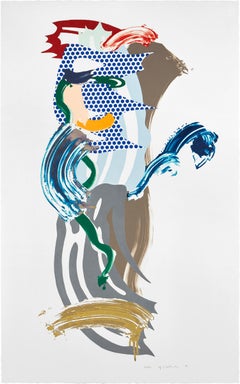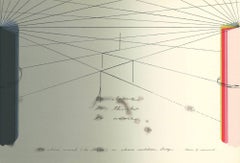Shusaku Arakawa Art
to
1
13
1
2
7
7
1
3
6
2
2
Overall Height
to
Overall Width
to
7
3
2
1
1
1
1
1
14
3
7
3
14
6,827
3,109
2,517
1,217
10
6
3
1
1
Artist: Shusaku Arakawa
Still Life, from To and From Rrose Selavy, for Marcel Duchamp, Lt Ed silkscreen
By Shusaku Arakawa
Located in New York, NY
Shusaku Arakawa
Still Life, from To and From Rrose Selavy, for Marcel Duchamp, 1967
Limited Edition Silkscreen on velincarton (thin board) paper
10 1/2 × 13 1/4 inches
Limited Edition of 60
Hand signed, titled and dated on the front
Unframed
The entire portfolio, including the present work, is referenced in the Marcel Duchamp catalogue raisonne: Arturo Schwarz The Complete Works of Marcel Duchamp, Abrams, P.532, 344c
Eager to share Marcel Duchamp with Japanese audiences, Shuzo Takiguchi - a Japanese-born poet, critic, and artist with ties to Surrealist circles, assembled an international portfolio of graphic works by various artists with strong ties to Duchamp, to accompany the deluxe version of his monograph, "To and From Rrose Sélavy". The present work was created for this portfolio by one of Marcel Duchamp's friends, Shusaku Arakawa. It is signed, dated and titled on the front - and can be exhibited both vertically and horizontally - (see photos). The present work, along with others in the portfolio, was published in Japan and is rarely found stateside.
Shusaku Arakawa (荒川 修作 Arakawa Shūsaku, July 6, 1936 – May 18, 2010) who spoke of himself as an “eternal outsider” and “abstractionist of the distant future,” first studied mathematics and medicine at the University of Tokyo, and art at the Musashino Art University. He was a member of Tokyo’s Neo-Dadaism Organizers, a precursor to The Neo-Dada movement. Arakawa’s early works were first displayed in the infamous Yomiuri Independent Exhibition, a watershed event for postwar Japanese avant-garde art. Arakawa arrived in New York in 1961 with fourteen dollars in his pocket and a telephone number for Marcel Duchamp, whom he phoned from the airport and over time formed a close friendship. He started using diagrams within his paintings as philosophical propositions. Jean-Francois Lyotard has said of Arakawa’s work that it “makes us think through the eyes,” and Hans-Georg Gadamer has described it as transforming “the usual constancies of orientation into a strange, enticing game—a game of continually thinking out.” Quoting Paul Celan...
Category
1960s Dada Shusaku Arakawa Art
Materials
Screen, Mixed Media, Cardboard
Historic Dwan Gallery Poster: Presence or the Third Person
By Shusaku Arakawa
Located in New York, NY
Shusaku Arakawa
Historic Dwan Gallery Poster: Presence or the Third Person, 1967
Offset lithograph poster
30 x 22 inches
Unframed
Rarely found, coveted 1967 poster from the legendary...
Category
1960s Contemporary Shusaku Arakawa Art
Materials
Lithograph, Offset
The Degrees of Meaning
By Shusaku Arakawa
Located in New York, NY
The Degrees of Meaning
1973
Signed and numbered, recto
Lithograph
31 x 23.25 inche
This work is offered by CLAMP in New York City.
Category
1970s Contemporary Shusaku Arakawa Art
Materials
Lithograph
Arakawa at Galerie Maeght exhibition poster
By Shusaku Arakawa
Located in New York, NY
Shusaku Arakawa
Arakawa at Galerie Maeght, 1982
Offset Lithograph Poster
27 1/2 × 20 1/4 inches
Unframed
This collectible offset lithograph poster was created on the occasion of the ...
Category
1980s Abstract Shusaku Arakawa Art
Materials
Lithograph, Offset
The Degrees of Meaning, from Realities and Paradoxes
By Shusaku Arakawa
Located in New York, NY
Shusaku Arakawa
The Degrees of Meaning, from Realities and Paradoxes, 1973
Color Lithograph and Silkscreen
Hand signed, numbered from the edition of only 100 and dated on the front (lower right hand corner). Bears the Styria Studio blind stamp
Frame Included
Hand signed, numbered from the limited edition of only 100 and dated on front lower right hand corner with blind stamp.
This work is from the Realities and Paradoxes portfolio. It is classic Arakawa - an important example of his way of displacing sometimes cryptic words onto images as a form of artistic philosophy and performance. Shusaku Arakawa (荒川 修作 Arakawa Shūsaku, July 6, 1936 – May 18, 2010) who spoke of himself as an “eternal outsider” and “abstractionist of the distant future,” first studied mathematics and medicine at the University of Tokyo, and art at the Musashino Art University. He was a member of Tokyo’s Neo-Dadaism Organizers, a precursor to The Neo-Dada movement. Arakawa’s early works were first displayed in the infamous Yomiuri Independent Exhibition, a watershed event for postwar Japanese avant-garde art. Arakawa arrived in New York in 1961 with fourteen dollars in his pocket and a telephone number for Marcel Duchamp, whom he phoned from the airport and over time formed a close friendship. He started using diagrams within his paintings as philosophical propositions. Jean-Francois Lyotard has said of Arakawa’s work that it “makes us think through the eyes,” and Hans-Georg Gadamer has described it as transforming “the usual constancies of orientation into a strange, enticing game—a game of continually thinking out.” Quoting Paul Celan...
Category
1970s Contemporary Shusaku Arakawa Art
Materials
Lithograph, Screen
Dear Picasso, from Homage to Picasso portfolio
By Shusaku Arakawa
Located in New York, NY
Shusaku Arakawa
Dear Picasso, from Homage to Picasso portfolio, 1973 (Hommage a Picasso)
Color Silkscreen on Satin Arches Velincarton
Hand signed and numbered in graphite pencil on t...
Category
1970s Contemporary Shusaku Arakawa Art
Materials
Screen
Double Point Blank
By Shusaku Arakawa
Located in New York, NY
Shusaku Arakawa
Double Point Blank, 1979
Lithograph on paper with deckled edges
Hand signed, numbered 13/45 and titled with publisher's and printer's blind stamp on lower front and printer's stamp on the back
35 × 60 inches
Unframed
Photos don't do justice to this impressive print! This interesting and uncommon conceptual lithograph by Arakawa was published from the limited edition of only 45. This late 1970s work, published by Topaz Editions in Florida, would make an excellent addition to any serious Arakawa collection. Hand signed, titled, numbered and dated on lower recto (front) with printer's and publisher's blind stamp and printer's stamp and inventory number on verso (back).
Shusaku Arakawa (荒川 修作 Arakawa Shūsaku, July 6, 1936 – May 18, 2010) who spoke of himself as an “eternal outsider” and “abstractionist of the distant future,” first studied mathematics and medicine at the University of Tokyo, and art at the Musashino Art University. He was a member of Tokyo’s Neo-Dadaism Organizers, a precursor to The Neo-Dada movement. Arakawa’s early works were first displayed in the infamous Yomiuri Independent Exhibition, a watershed event for postwar Japanese avant-garde art. Arakawa arrived in New York in 1961 with fourteen dollars in his pocket and a telephone number for Marcel Duchamp, whom he phoned from the airport and over time formed a close friendship. He started using diagrams within his paintings as philosophical propositions. Jean-Francois Lyotard has said of Arakawa’s work that it “makes us think through the eyes,” and Hans-Georg Gadamer has described it as transforming “the usual constancies of orientation into a strange, enticing game—a game of continually thinking out.” Quoting Paul...
Category
1970s Contemporary Shusaku Arakawa Art
Materials
Lithograph
Blankless Tone
By Shusaku Arakawa
Located in New York, NY
Shusaku Arakawa
Blankless Tone, 1979
Color lithograph and silkscreen with embossing on Arches paper with deckled edges and folded collage upper left
Hand-signed by artist, Titled "Bl...
Category
1970s Contemporary Shusaku Arakawa Art
Materials
Lithograph, Screen
Untitled 3 from "No!" Says the Signified, signed proof, aside from the ed. of 40
By Shusaku Arakawa
Located in New York, NY
Shusaku Arakawa
Untitled 3 from "No!" Says the Signified, 1973
Lithograph and Silkscreen on Arches Paper with Deckled Edges
Hand signed and dated on the lower right front
Artist's Pr...
Category
1970s Conceptual Shusaku Arakawa Art
Materials
Lithograph, Screen, Pencil
Outside Blank
By Shusaku Arakawa
Located in Henderson, NV
Arakawa made an impact on the New York art world during the 1980s.
Category
1980s Abstract Geometric Shusaku Arakawa Art
Materials
Paper, Lithograph
original lithograph
By Shusaku Arakawa
Located in Henderson, NV
Medium: original lithograph. Printed in 1982 for the art revue Derriere le Miroir (issue number 250), and published in Paris by Maeght. Image size: 15 x 12 1/4 inches (380 x 310 mm)....
Category
1980s Shusaku Arakawa Art
Materials
Lithograph
A Man Walking
By Shusaku Arakawa
Located in New York, NY
Shusaku Arakawa
A Man Walking, 1968
Silkscreen on velincarton (thin board)
29 4/5 × 21 4/5 inches
Edition of 100
Hand signed and numbered from the edition of 100 on the recto
Another rarely seen, richly colored mid century silkscreen by Arakawa, whose estate is represented by Gagosian Gallery. This work has only appeared a handful of times at public auction over the past half century.
Shusaku Arakawa (荒川 修作 Arakawa Shūsaku, July 6, 1936 – May 18, 2010) who spoke of himself as an “eternal outsider” and “abstractionist of the distant future,” first studied mathematics and medicine at the University of Tokyo, and art at the Musashino Art University. He was a member of Tokyo’s Neo-Dadaism Organizers, a precursor to The Neo-Dada movement. Arakawa’s early works were first displayed in the infamous Yomiuri Independent Exhibition, a watershed event for postwar Japanese avant-garde art. Arakawa arrived in New York in 1961 with fourteen dollars in his pocket and a telephone number for Marcel Duchamp, whom he phoned from the airport and over time formed a close friendship. He started using diagrams within his paintings as philosophical propositions. Jean-Francois Lyotard has said of Arakawa’s work that it “makes us think through the eyes,” and Hans-Georg Gadamer has described it as transforming “the usual constancies of orientation into a strange, enticing game—a game of continually thinking out.” Quoting Paul Celan, Gadamer also wrote of the work: "There are songs to sing beyond the human." Arthur Danto has found Arakawa to be “the most philosophical of contemporary artists." For his part, Arakawa has declared: “Painting is only an exercise, never more than that.” Arakawa and Madeline Gins...
Category
1960s Abstract Geometric Shusaku Arakawa Art
Materials
Screen
USE THE FACT THAT - Lithograph by Shusaku Arakawa - 1973
By Shusaku Arakawa
Located in Roma, IT
USE THE FACT THAT is an original contemporary artwork by Shusaku Arakawa in 1973.
Mixed colored lithograph.
Hand signed and dated on the lower right margin. Numbered on the lower l...
Category
1970s Contemporary Shusaku Arakawa Art
Materials
Lithograph
"Galerie Maeght, " Offset Poster by Shusaku Arakawa
By Shusaku Arakawa
Located in Milwaukee, WI
Designed by Shusaku Arakawa, this was a poster for his exhibition at the Galerie Maeght in Paris, 1977.
Shusaku Arakawa was a Japanese artist and architect. Shusaku Arakawa, who spoke of himself as an “eternal outsider” and “abstractionist of the distant future,” first studied mathematics and medicine at the University of Tokyo, and art at the Musashino Art University. He was a member of Tokyo’s Neo-Dadaism Organizers, a precursor to The Neo-Dada movement. Arakawa’s early works were first displayed in the infamous Yomiuri Independent Exhibition, a watershed event for postwar Japanese avant-garde art. Arakawa arrived in New York in 1961 with fourteen dollars in his pocket and a telephone number for Marcel Duchamp, whom he phoned from the airport and with whom he eventually formed a close friendship. He started using diagrams within his paintings as philosophical propositions. Jean-Francois Lyotard said of Arakawa’s work that it “makes us think through the eyes,” and Hans-Georg Gadamer described it as transforming “the usual constancies of orientation into a strange, enticing game—a game of continually thinking out.” Quoting Paul Celan, Gadamer also wrote of the work: "There are songs to sing beyond the human." Charles Bernstein and Susan Bee observe, "Arakawa deals with the visual field as discourse, modal systems that constitute the world rather than being constituted by it." Arthur Danto found Arakawa to be “the most philosophical of contemporary artists." For his part, Arakawa declared: “Painting is only an exercise, never more than that.” Beginning in 1963, he collaborated with fellow artist, architect and poet Madeline Gins...
Category
Late 20th Century Shusaku Arakawa Art
Materials
Offset
Related Items
Blue Face from the Brushstroke Figures Series
By Roy Lichtenstein
Located in Miami, FL
Lithograph, waxtype woodcut and screenprint on 638-g/m cold-pressed Saunders Waterford Paper. From the "Brushstroke Figures" series, 1989. Hand signed rf Lichtenstein, dated ('89) a...
Category
1980s Contemporary Shusaku Arakawa Art
Materials
Lithograph, Screen, Woodcut
Free Shipping
H 53.7 in W 38.9 in
Tea for two – Tod
By Harry Bunce
Located in Deddington, GB
Tea for two – Tod by Harry Bunce [2017]
limited_edition
Screen Print
Edition number 146
Image size: H:25 cm x W:31 cm
Complete Size of Unframed Work: H:41 cm x W:49 cm x D:0.3cm
Sol...
Category
2010s Contemporary Shusaku Arakawa Art
Materials
Paper, Screen
Signed 1960s Jean DUBUFFET print (Jean Dubuffet exhibition poster)
By Jean Dubuffet
Located in NEW YORK, NY
Jean Dubuffet Ustensiles Utopiques 1966:
Hand-signed Jean Dubuffet lithographic poster published on the occasion of: "Jean Dubuffet, Recent Pa...
Category
1960s Contemporary Shusaku Arakawa Art
Materials
Offset, Laid Paper, Lithograph
Western Pals
By Red Grooms
Located in Lyons, CO
Color lithograph, Edition 40.
Red Grooms is a painter, sculptor, printmaker, filmmaker, and showman par excellence. His major installations, “Ruckus Manhattan”, “The City of Chicago...
Category
1990s Contemporary Shusaku Arakawa Art
Materials
Lithograph
1960s James Rosenquist F-111 announcement
By (after) James Rosenquist
Located in NEW YORK, NY
James Rosenquist F-111 announcement:
Vintage original folding exhibition pamphlet published on the occasion of a 1960’s exhibition in Stockholm at the Museet Moderna: September 29th-October 18th 1965. Features a reproduction of Rosenquist’s famed “F-111”. Folding out to four portions, the reverse chronicles an extensive interview (in Swedish) between Rosenquist & the museum. Rare and highly collectible.
Medium: Offset printed fold-out museum pamphlet.
Condition: Quattro fold-lines as issued; good overall vintage condition.
Dimensions: 5.5 x 11 inches (opening to 5.5 x 44 inches).
Unsigned from an edition of unknown; rare.
Rosenquist began the painting F-111 in 1964, in the middle of the Vietnam War. He positioned his main subject, the F-111 military plane, which was in development at the time, flying through fragmented images of consumer products and references to war. Through its expansive network of colliding visual motifs, F-111 addresses the connections between the Vietnam War, income taxes, consumerism, and advertising.
James Rosenquist was an American Pop artist known for his monumental paintings and prints. Often appropriating commercial imagery, his montage-like works combined popular culture, surrealism, and historical painting methods. “Much of the aesthetic of my work comes from doing commercial art,” the artist once said. “I painted pieces of bread, Arrow shirts...
Category
1960s Contemporary Shusaku Arakawa Art
Materials
Offset, Lithograph
Vintage Pop Art 1997 Offset Lithograph Larry Rivers Music Poster Hamptons NY
By Larry Rivers
Located in Surfside, FL
Larry Rivers
"The Music Festival of the Hamptons / July 18-27 1997" poster,
Not hand signed. [Dimensions: 24" H x 18" W]
Larry Rivers (born Yitzroch Loiza Grossberg) (1923 – 2002) was an American artist, musician, filmmaker, and occasional actor. Considered by many scholars to be the "Godfather" and "Grandfather" of Pop art, he was one of the first artists to merge non-objective, non-narrative art with narrative and objective abstraction.
Rivers took up painting in 1945 and studied at the Hans Hofmann School from 1947–48. He earned a BA in art education from New York University in 1951.
His work was quickly acquired by the Museum of Modern Art. A 1953 painting Washington Crossing the Delaware was damaged in fire at the museum five years later.
He was a pop artist of the New York School, reproducing everyday objects of American popular culture as art. He was one of eleven New York artists featured in the opening exhibition at the Terrain Gallery in 1955 along with Paul Mommer, Leonard Baskin, Peter Grippe
During the early 1960s Rivers lived in the Hotel Chelsea, notable for its artistic residents such as Bob Dylan, Janis Joplin, Leonard Cohen, Arthur C. Clarke, Dylan Thomas, Sid Vicious and multiple people associated with Andy Warhol Factory and where he brought several of his French nouveau réalistes friends like Yves Klein who wrote there in April 1961 his Manifeste de l'hôtel Chelsea, Arman, Martial Raysse, Jean Tinguely, Niki de Saint-Phalle, Christo & Jean Claude, Daniel Spoerri or Alain Jacquet, several of whom, like Rivers, left some pieces of art in the lobby of the hotel for payment of their rooms. In 1965, Rivers had his first comprehensive retrospective in five important American museums.
His final work for the exhibition was The History of the Russian Revolution, which was later on extended permanent display at the Hirshhorn Museum and Sculpture Garden in Washington, DC. He spent 1967 in London collaborating with the American painter Howard Kanovitz.
In 1968, Rivers traveled to Africa for a second time with Pierre Dominique Gaisseau to finish their documentary Africa and I, which was a part of the groundbreaking NBC series Experiments in Television. During this trip they narrowly escaped execution as suspected mercenaries.
During the 1970s, Rivers worked closely with Diana Molinari and Michel Auder on many video tape projects, including the infamous Tits, and also worked in neon.
Rivers's legs appeared in John Lennon and Yoko Ono's 1971 film Up Your Legs Forever.
From 1940–1945 he worked as a jazz saxophonist in New York City, changing his name to Larry Rivers in 1940 after being introduced as "Larry Rivers and the Mudcats" at a local pub. He studied at the Juilliard School of Music in 1945–46, along with Miles Davis, with whom he remained friends until Davis's death in 1991.
Larry Rivers was born in the Bronx to Samuel and Sonya Grossberg, Jewish immigrants from Ukraine. In 1945, he married Augusta Berger, and they had one son, Steven. Rivers also adopted Berger's son from a previous relationship, Joseph, and reared both children after the couple divorced. In 1949 he had his first one-man exhibition at the Jane Street Gallery in New York. This same year, he met and became friends with John Ashbery, and Kenneth Koch. In 1950 he met Frank O’Hara. This same year he took his first trip to Europe spending eight months in Paris, France, reading and writing poetry. Beginning in 1950 and continuing until Frank’s death in July of 1966, Larry Rivers and Frank O’Hara cultivated a uniquely creative friendship that produced numerous collaborations, as well as inspired paintings and poems. In 1951 Rivers’ works were shown at the Tibor de Nagy Gallery where he continued to show annually (except 1955) for about 10 years. In 1954 he had his first exhibition of sculptures at the Stable Gallery, New York. In 1955 The Museum of Modern Art acquired Washington Crossing the Delaware. This same year he won 3rd prize in the Corcoran Gallery national painting competition for “Self-Figure.” Rivers’ also painted “Double Portrait of Berdie” in 1955, which was soon purchased by the Whitney Museum.
In 1957 he and Frank O’Hara began work on “Stones,” a collaborative mix of images and poetry in a series of lithograph for Tatyana Grosman company ULAE. During this time he also appeared on the television game show “The $64,000.00 Question” where along with another contestant, they both won, each receiving $32,000.00. In 1958 he again spent time in Paris and played in various jazz bands. In 1959 he painted Cedar Bar Menu...
Category
1990s Pop Art Shusaku Arakawa Art
Materials
Lithograph, Offset
ALGARVE LANDSCAPE Signed Lithograph, Minimalist White Houses, Blue, Beige, Gray
By Mary Faulconer
Located in Union City, NJ
ALGARVE LANDSCAPE is an original hand drawn lithograph by the American woman artist Mary Faulconer printed using traditional lithography techniques on archival paper 100% acid free. ...
Category
1970s Contemporary Shusaku Arakawa Art
Materials
Lithograph
1970s Modernist Swiss Colorful Surrealism Signed Dada Lithograph Andre Thomkins
By André Thomkins
Located in Surfside, FL
This one is titled "Walk in a Broken Lake" and depicts a surreal figure of a robed woman walking in an abstract landscape in yellow, green, red and blue with a Salvador Dali esque quality about it.
Published by Edition Hansjörg Mayer, Stuttgart They published concrete poetry and art books by Mark Boyle, Richard Hamilton, Dorothy Iannone, John Latham, Tom Phillips, Dieter Roth, André Thompkins and Emmett Williams, to name just a few.
André Thomkins (1930 - 1985) was a Swiss painter, illustrator, and poet. He attended art-school, taught by Max von Moos, 1947 – 1949 and the Académie de la Grande Chaumière, Paris, France, 1950. From 1952, he lived in Germany and taught at the Kunstakademie Düsseldorf between 1971 and 1973.
Thomkins painted and drew ironic and fantastic pictures influenced by surrealism and dadaism. Together with Dieter Roth and Daniel Spoerri he prepared works of Eat Art. He also was a writer of palindromes. His friends and collaborators included Daniel Spoerri, Dieter Roth, George Brecht, Richard Hamilton and Karl Gerstner, Thomkins gained a reputation as an ‘artist’s artist’, and is considered one of the most important Swiss artists of the second half of the twentieth century.He died in 1985.
His work is currently represented by Hauser & Wirth Zurich, Switzerland.
Select group exhibitions:
2018
Kunsthalle Krems, 'Pablo Picasso. Arshile Gorky, Andy Warhol. Sculptures and Works on Paper. Hubert Looser Collection', Krems, Austria
2017
Kunsthandel Wolfgang Werner, 'Martin Barré, Karl Otto Götz, Ernst Wilhelm Nay, André Thomkins',
Berlin, Germany
2013
Fabian & Claude Walter Galerie, 'Schweizer Avantgarde Kunst nach 1940', Zurich, Switzerland
2009
The Modern Institute, 'Thomas Houseago, Dieter Roth, Andre Thomkins', Glasgow, England
Museum of Modern Art, 'Compass in Hand: Selections from the Judith Rothschild Collection', NYC
2004
Kunsthandel Wolfgang Werner, 'Arman, Baumeister, Götz, Graubner, Tàpies, Thomkins', Berlin,
Germany
1994
Kunstmuseum Solothurn, 'Eine Schenkung. Grafik von Eduardo Chillida, Antoni Tàpies, Alexander Calder, Jean Dubuffet, Ben Nicholson, Giacometti, Tinguely, Thomkins', Solothurn, Switzerland
1992
Galerie Littmann, Tinguely zu Ehren. A Tribute to Jean Tinguely. Hommage à Tinguely, Basel,
1988
Museum Ludwig, 'Uebrigens sterben immer die anderen. Marcel Duchamp und die Avantgarde seit
1950', Cologne, Germany
1987
Aargauer Kunsthaus, 'Otto Grimm. Marc-Antoine Fehr. Christoph Gredinger', Aarau, Switzerland
Cercle Municipal, 'Art contemporain suisse. Collection de la Banque du Gothard', Luxembourg,
1985
Centre national d'art et de culture Georges Pompidou, 'Livres d'artistes', Paris, France
Rathaus, 'Claude Sandoz – Hans Schärer...
Category
1970s Surrealist Shusaku Arakawa Art
Materials
Lithograph, Offset
Whitney Construction at Dusk
By Yvonne Jacquette
Located in Lyons, CO
Color lithograph, Edition 30
In this intensely colorful print, Jacquette captured this view of early stages in the construction of the new Renzo Piano building from an elevated perch in the Standard...
Category
21st Century and Contemporary Contemporary Shusaku Arakawa Art
Materials
Lithograph
ST0034-Contemporary, Abstract prints, stil-life, figurative, nude, landscape
By Francisco Nicolás
Located in London, London
Digital pigment print Ultrachrome ink on Fabriano Rosaspina paper. Hand signed by the artist, and certificate of authenticity. Edition of 25 (Unframed)
His work has been shown in R...
Category
2010s Abstract Shusaku Arakawa Art
Materials
C Print, Inkjet, Color, Pigment, Archival Pigment, Mixed Media, Paper
H 15.75 in W 11.82 in D 0.4 in
DADA Artist Abstract Figures Silkscreen Lithograph Print Israeli Modernist
By Marcel Janco
Located in Surfside, FL
Marcel Janco, was a Romanian and Israeli visual artist, architect and art theorist. He was the co-inventor of Dadaism and a leading exponent of Constructivism in Eastern Europe. In...
Category
20th Century Modern Shusaku Arakawa Art
Materials
Screen, Lithograph
Joan Miró Lithograph Derriere Le Miroir
By Joan Miró
Located in NEW YORK, NY
1970s Joan Miró Lithograph
Portfolio: Derriere Le Miroir, 1973.
Published by: Galerie Maeght, Paris.
Off-set lithograph in colors.
15x22 inches.
Center fold-line as issued; very g...
Category
1960s Contemporary Shusaku Arakawa Art
Materials
Lithograph, Offset
Previously Available Items
1974 Shusaku Arakawa 'A Forgettance (Exhaustion Exhumed)' Contemporary Gray
By Shusaku Arakawa
Located in Brooklyn, NY
Paper Size: 14.25 x 38 inches ( 36.195 x 96.52 cm )
Image Size: 11.5 x 36 inches ( 29.21 x 91.44 cm )
Framed: No
Condition: A-: Near Mint, very light signs of handling
Addition...
Category
1970s Shusaku Arakawa Art
Materials
Offset
H 14.25 in W 38 in D 0.1 in
Abtract Geometric Composition
By Shusaku Arakawa
Located in Kansas City, MO
Shusaku Arakawa
Title: Abstract Geometric Composition
Medium: Lithograph
Year: 1977
Edition: Limited
Publisher: Maeght, Paris
Size: 14.8 × 21.8 inches
Shusaku Arakawa (荒川 修作 Arakawa Shūsaku, July 6, 1936 – May 18, 2010) was a Japanese artist and architect. He had a personal and artistic partnership with writer and artist Madeline Gins...
Category
1970s Modern Shusaku Arakawa Art
Materials
Lithograph
"A Forgettance (Exhaustion Exhumed), " Large Diptych, 1974-75
By Shusaku Arakawa
Located in Long Island City, NY
Artist: Shusaku Arakawa, Japanese (1936 - 2010)
Title: A Forgettance (Exhaustion Exhumed)
Year: 1974-75
Edition: 60
Medium: Two Panels, Screenprint and Lithograph with Embossing, s...
Category
1970s Conceptual Shusaku Arakawa Art
Materials
Screen
"Iris Field: I See the Ceiling From my Bed, " Screenprint and Lithograph, 1974
By Shusaku Arakawa
Located in Long Island City, NY
Artist: Shusaku Arakawa, Japanese (1936 - 2010)
Title: Iris Field: I See the Ceiling From my Bed
Year: 1974
Edition: 60
Medium: Screenprint and Lithograph w...
Category
1970s Conceptual Shusaku Arakawa Art
Materials
Lithograph, Screen
Shusaku Arakawa art for sale on 1stDibs.
Find a wide variety of authentic Shusaku Arakawa art available for sale on 1stDibs. If you’re browsing the collection of art to introduce a pop of color in a neutral corner of your living room or bedroom, you can find work that includes elements of purple and other colors. You can also browse by medium to find art by Shusaku Arakawa in lithograph, screen print, offset print and more. Much of the original work by this artist or collective was created during the 20th century and is mostly associated with the contemporary style. Not every interior allows for large Shusaku Arakawa art, so small editions measuring 14 inches across are available. Customers who are interested in this artist might also find the work of Akio Takamori, Katsunori Hamanishi, and George Chemeche. Shusaku Arakawa art prices can differ depending upon medium, time period and other attributes. On 1stDibs, the price for these items starts at $100 and tops out at $8,800, while the average work can sell for $2,500.
